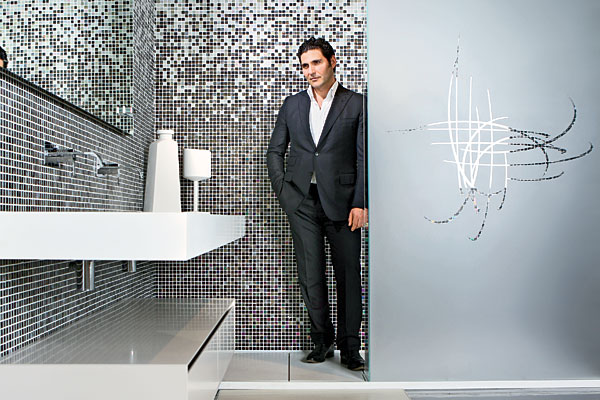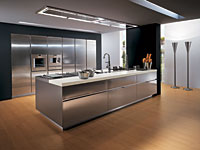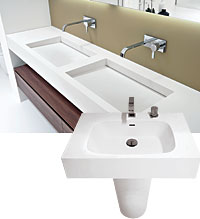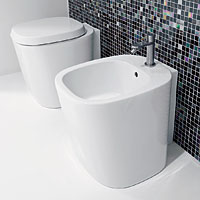
Lanzetta stands in an Antonio Lupi shower with a frosted glass wall that cheekily depicts a finger drawing on a steamy surface (designs are customizable). The Lupi showroom opened in April.
Italians are known for being particular when it comes to aesthetics. And Rome-born, Milan-raised Luca Lanzetta is no exception. An engineer by trade, he moved to Chicago in 1998 to start a company that imports manufacturing equipment for Boeing, Caterpillar, and GM. He still has this business, but a life filled with heavy machinery couldn’t possibly satisfy an architect’s son who grew up eating meals at a Saarinen table surrounded by Bauhaus chairs, and studied mechanical engineering at Politecnico di Milano, whose graduates include such Italian design heavyweights as Antonio Citterio and Piero Lissoni. In 2007, Lanzetta opened Ernestomeda, a kitchen showroom at LuxeHome at the Merchandise Mart; this past spring, he opened Antonio Lupi, a bath showroom, on Wells Street. Both are Italian. Both are clean and minimalist—Lanzetta, who is intimately involved with the design and installation of all his products, wouldn’t have it any other way. A brief conversation with him reveals that when it comes to design, he notices everything, and many things—from the “ugly Home Depot hardware on doors” to the “little light switches that stick out of the wall in so many homes”—irk him. “I’m always wanting to redo things, even in my own home,” he says. “So it’s nice to have showrooms where I can do this.” Lanzetta shared some of his passion for Italian kitchen and bath design with us.
How would you compare the American approach to design to the Italian?
In America, richness is often measured in quantity. In Italy, it’s about simplicity. About finding the right thing. A lot of things piled on—that’s ugly. The architecture in Italy, other than the Baroque, is rich but not overdone. It’s balanced. That’s what everything is about in Italy. Take pizza—there, a Margherita pizza is just tomatoes and mozzarella. Here, people put chicken and pork on it. It’s the same with Italian fashion. If you want to see what design and haute couture have in common, watch the documentary Valentino: King of Couture. People say fashion is superficial, but they should see the attention to detail, the tailoring. It’s all about finding the right thing. How does your body look in that dress? How do you live in that bathroom?

Lanzetta’s ideal kitchen would have an island, a wall of cabinets and appliances, and nothing else but a table. Shown here is Ernestomeda’s Elektra kitchen in stainless steel.
What conventions of American kitchens are you fed up with?
Everybody has to have a breakfast bar with stools in their kitchen. I prefer to sit down at the table to have a drink. It’s more formal—you can look at each other’s faces. Kitchen islands are good for preparation, for cooking together. You should include as much as you can in the island—two sinks, a cooktop, whatever you need. I can even imagine two islands if the space is big enough. But eat and drink at the table.
What do you think of exposed shelving for storing dishes?
An open shelf should be for decoration, not function. I like a simple glass shelf, with an aluminum edge, for putting some glasses on top. Pots and pans should be stored in drawers so they are easy to access.
What would your ideal kitchen look like?
I would always have an island. I would put all the refrigeration, the ovens, coffeemaker, microwave, even a TV, in tall units along one wall, and on the same wall a big pantry for food storage. That’s it—the kitchen would consist of a long wall of equipment and storage, like 12 feet, and a big island, also 12 feet, and 2 feet wide, containing a fully integrated cooktop and sink, with drawers on each side. And of course a long table where you can sit down to eat.

Lupi’s Slot, shown in a nine-foot double-sink style (also sold in a single-sink version) and Body1 pedestal are shown with Block Light faucets.

Lanzetta likes a streamlined toilet and a bidet to go with it. Shown here, pieces from the Mascolo collection
Let’s talk bathrooms. What don’t you like?
Mirrors with big frames. Sconces. Too many fixtures. Too much brass. And how come there are no bidets in America? That is not hygienic. Also, so many people have a big Jacuzzi that they don’t use. And everywhere the undermount sink!
So what should we do?
Put a nice, interesting soaking tub in place of the Jacuzzi. An architectural piece makes the room beautiful. You don’t want to see the sink? Integrate it fully into the countertop. Make it invisible [Antonio Lupi’s shallow Slot sink appears to be nearly flush with the countertop and is designed so that the drain is barely visible]. If you want to see it, then it has to be impeccable. Not necessarily a $20,000 sink [he is referring to a round, freestanding sink carved out of a solid hunk of stone that’s in the showroom]. Antonio Lupi makes pedestal-style sinks for less that are beautiful. Then all you need is a long mirror and a nice faucet for your powder room and people will say, “Who is this guy? He’s got good taste.”
What else would you like to see in there?
You’ll see in our Antonio Lupi showroom that we have a mesh cowhide chair in one area and bookshelves in another. The bathroom is a place to relax. It should be an extension of the living room. Of course, the toilet and bidet are always private, separated from the main space.
Would you ever sell a client a kitchen or bathroom you didn’t like?
When we first opened Ernestomeda, we did. But now we won’t. Because you need to feel our passion in the finished product.
CONTACT ERNESTOMEDA, 128 MERCHANDISE MART, 312-329-0229; ANTONIO LUPI, 516 N. WELLS ST., 312-329-1550.
Photograph: Katrina Wittkamp


